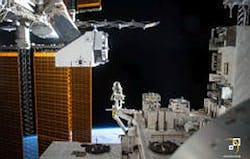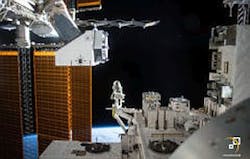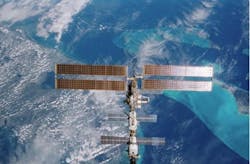ISS astronauts swap electronics, sensor payload in NanoRacks platform for testing in extreme space environment
HOUSTON. The NanoRacks External Platform (NREP) has been reinstalled on the outside of the International Space Station (ISS), initiating the commercial platform’s third customer mission. The NREP is hosting the Cavalier Space Processor payload, which includes a 10 by 10 by 40 centimeter aluminum enclosure, an externally mounted antenna, and internal processing electronics.
The self-funded NanoRacks External Platform commercial gateway to the extreme environment of space enables users to experience the microgravity, atomic oxygen, radiation, and other harsh elements native to the space environment and observe Earth, test sensors, materials, and electronics, while having the opportunity to return the payload back to Earth, officials say.
This External Platform mission is hosting the Cavalier Space Processor payload, which consists of a 10 by 10 by 40 centimeter aluminum enclosure, an externally mounted antenna, and internal processing electronics. Cavalier is a receive-only experiment, and does not have transmitting capability.
Multiple NanoRacks External Platform (NREP) payloads are transferred from the cargo vehicle to the Japanese Experiment Module (JEM). The NREP payloads are inspected for visual damage, and installed onto the NREP facility. The NREP is then installed on the slide table, and transferred external to ISS via the JEM airlock. The JEM Remote Manipulating System (JRMS) is operated to grapple the NREP and place in position on the JEM Exposed Facility. The mission duration is approximately six months before the payload is returned to the JEM airlock. Cavalier is autonomous, and once power is applied continues running until commanded to shut down, or power is removed.
Cavalier on NanoRacks External Platform (NREP). The NREP Experiment Base Plate and payload position numbering system are shown (Experiment Base Plate is shown detached from the NREP for clarity). The Cavalier payload is attached at location #3. Image courtesy of NanoRacks.
“I’d like to give a big thank you to Astronaut Norishige Kanai for the managing the successful payload swap out and installation, and thank you as well to Astronaut Scott Tingle for the added support,” says NanoRacks Operations Engineer Jerry Mathew. “It has been wonderful working with this crew and we look forward to continued successful payload operations for the duration of this mission.”
Cavalier was recently launched on the Orbital ATK CRS-8 (OA-8) mission on 12 November 2017.
NREP, which is self-funded by NanoRacks, is externally mounted to the ISS on the Japanese Experiment Module Exposed Facility and provides a commercial gateway to the extreme space environment.
Following the CubeSat form factor, payloads can experience microgravity and radiation, observe earth, test sensors and electronics, and experience other harsh elements native to the space – while having the ability to return the payload back to Earth.
The External Platform is also a stepping-stone in NanoRacks’ growing programs towards building a deeper understanding of working in the outside environment of space, including developments in both the NanoRacks Airlock Module and the Ixion program.
NanoRacks is enabling space research and in-space services to customers worldwide from multiple platforms and launch vehicles. The company offers low-cost, high-quality solutions to the most pressing needs for satellite deployment, basic and educational research at home and in 30 nations worldwide for those new to the industry and aerospace veterans, officials say.
In July 2015, NanoRacks signed a teaming agreement with Blue Origin to offer integration services on their New Shepard space vehicle. NanoRacks, along with partners at ULA and Space Systems Loral was also selected by NASA to participate in the NextSTEPs Phase II program to develop commercial habitation systems in low-Earth orbit and beyond.
As of January 2018, over 600 payloads have been launched to the International Space Station via NanoRacks services, and our customer base includes the European Space Agency (ESA) the German Space Agency (DLR,) the American space agency (NASA,) US Government Agencies, Planet Labs, Millennium Space Systems, Space Florida, NCESSE, Virgin Galactic, pharmaceutical drug companies, and organizations in Vietnam, UK, Romania and Israel.
The go-to resource for Intelligent Aerospace technology news & information:
Covering key topics
Across all market segments
Subscribe to the free Intelligent Inbox e-newsletter: http://www.intelligent-aerospace.com/subscribe.html.
Connect on social media:
Keep pace with aerospace innovation and opportunities via your favorite social media channels. Connect with Intelligent Aerospace on Twitter (@IntelligentAero), LinkedIn,Google+, and Instagram.




